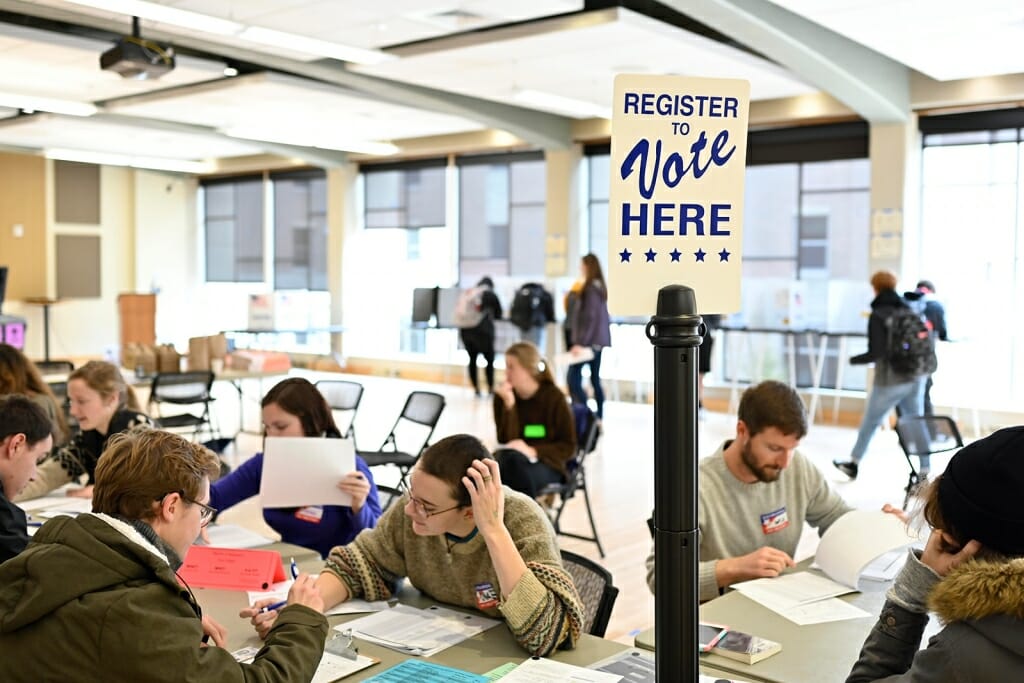Voting on UW-Madison campus up in 2018

Students register to vote before filling out midterm election ballots at the Frank Holt Center on campus on Nov. 6, 2018. Photo: Jeff Miller
The University of Wisconsin–Madison today reported that student voting on campus was up in last year’s election, increasing to 52.9 percent in 2018 from a rate of 35.6 percent in 2014, thanks in part to university-led efforts to encourage voting. The full campus report can be viewed here.
“These results show that we as students were excited to vote in 2018,” said Laura Downer, chair of the Associated Students of Madison. “We want to have a say in the future of our country, and we know how crucial voting is to amplifying our voice. I’m looking forward to even higher student participation in 2020!”
The report is part of the National Study of Learning, Voting, and Engagement, conducted by the Institute for Democracy & Higher Education (IDHE) at Tufts University. The study shows that nationwide, the voting rates at participating college campuses doubled on average compared to the previous 2014 midterm.
In 2018, the Average Institutional Voting Rate (AIVR) among campuses in the study was 39.1 percent, nearly 20 percentage points higher than 2014’s average turnout rate of 19.7 percent. Turnout increases were widespread, with virtually all campuses seeing an increase over 2014.
During the 2018 election season, UW–Madison participated in the Big Ten Voting Challenge, a nonpartisan effort that aimed to mobilize registration and turnout at all 14 Big Ten universities. When results of the competition are announced in October, trophies will go to the universities with the highest voter turnout and the most improved turnout in the Nov. 6 election.
The partnership between the Madison City Clerk’s Office, Associated Students of Madison, the Morgridge Center for Public Service, University Communications and a number of other campus units ensured that thousands of UW–Madison students were educated and engaged during the 2018 elections. The efforts, which won a 2019 Community-University Partnership Award, included registration drives, publicity efforts, discussion panels, a debate and chalking on Election Day. Dozens of student put in hundreds of volunteer hours.
“We’re pleased that UW–Madison students recognized the value of voting, and responded so well to the Big Ten Voting Challenge efforts,” said political science professor Barry Burden, the faculty chair for UW–Madison’s Big Ten Voting Challenge Committee. “We hope to teach our students the importance of civic involvement to our democracy.”
UW-Madison’s voting awareness efforts will continue in the presidential election year of 2020 under the leadership of the Badgers Vote Coalition, the successor group to the Big Ten Voting Challenge Committee.
Voter registration events held today
Efforts have already started to register students to vote, including today, on National Voting Registration Day.
A voter registration event will be held on Library Mall from 3 to 5 p.m., hosted by Badgers Vote and The Andrew Goodman Foundation. In addition, several voter registration events are being held throughout the city.
Some facts from the report about UW–Madison voting in 2018:
- The majors with the highest voting rates were library science at 73.4 percent and public administration and social service professions at 64.3 percent.
- Absentee voting accounted for 40.8 percent of UW–Madison students voting in 2018, and in-person Election Day voting accounted for 53.4 percent. In 2014, just 17.6 percent voted absentee, and 79.3 percent voted in-person on Election Day.
- First year-students had the highest voting rate, at 52.4 percent, with sophomores at 46.9 percent and upper-level students at 41.8 percent. Graduate students voted at a 44.5 percent level. In 2014, the first-year student voting rate was 24.4 percent; the sophomore rate was 26.4 percent and the upper-level student rate was 30.7 percent.
- The biggest increase in voting was in students aged 18-21, with 27.5 percent voting in 2014, and 45.1 percent in 2018.
- Voting turnout for women was 47.5 percent and for men was 44.1 percent in 2018.
Note: The above percentages appear lower than the overall voting rate of 52.4 percent, because the overall rate subtracted the number of students who are not eligible to vote.
The report is based on the National Study of Learning, Voting, and Engagement (NSLVE), conducted by IDHE, which is the only national study of college-student voting. It is based on the voting records of more than 10 million students at more than 1,000 colleges and universities in all 50 states and the District of Columbia; IDHE does not receive any information that could individually identify students or how they voted. The study provides reports to participating colleges and universities, like UW–Madison, which use them to support political learning and civic engagement, as well as to identify and address gaps in political and civic participation.
Tags: student life, voting




